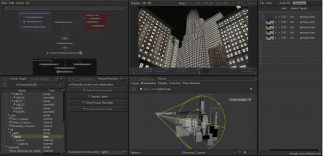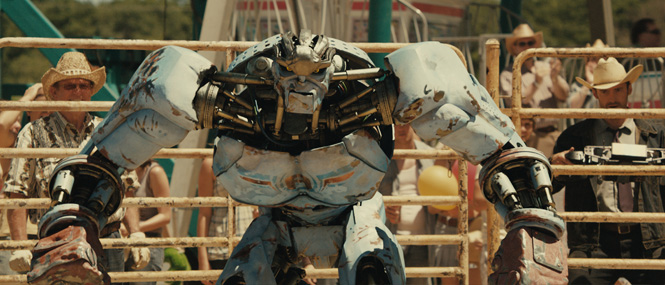The shipping of KATANA 1.0 is a significant milestone for The Foundry. ILM joins Digital Domain as the two companies which have invested in site licenses of KATANA. There is a third large facility which has invested in the software, but cannot be named publicly at this point in time. That makes three big companies who have bought in, even before the formal release of the software.
Since they acquired the tech from Sony Pictures Imageworks, they set a fairly concise plan for rolling out the product. While it brings many tools that could be useful for smaller to midsize facilities, in the early days of the product rollout, The Foundry has been concentrating on the larger facilities. But this won’t last for long.
According to The Foundry’s CEO Bill Collis, “we see KATANA as being something that should be useful to any company with an asset based approach. At present there are some technical requirements, in particular studios currently have to provide their own shader libraries, but a lot of our focus is now on turning KATANA into a fully featured product useful to all companies large and small.”
KATANA was acquired almost two years ago, and much of the development time since that point has been focused on making the software more open and be able to be integrated into a variety of pipelines. Since it was initially developed in-house at SPI, it was set up to work strictly within their pipeline. “In particular there are now APIs for integrating exisiting asset management and renderfarms systems into KATANA,” says Collis. “There is even an API for plugging completely new renderers into KATANA, which is invaluable to many of the big studios.”
This opening up of the software was an important part of having ILM dive in with a site license. Working out of the box with Alembic was also a great help to them. Most of the big studios are interested in flexibility and extensibility,” says Collis, “so a key part of our development for companies like ILM has been a proper C++ APIs to write plugins to KATANA (what we call ‘Scenegraph Generators’ and ‘Attribute Modifiers’).”
KATANA can bring a lot of efficiency to a studio pipeline. People commonly think of costs for 3D as being driven by large render farms, but the fact is that the time the artists spend working on the scenes are a significant cost. If they are spending less time managing and dealing with assets, more time can be spent on the creative things that matter. “KATANA has a great reputation with its existing users as a powerful tool that can deal with the ‘unreasonable demands’ (as Sony put it) of modern production,” says Collis. “They have a saying that ‘there’s always a way to do it in KATANA’, and I think one of the big things the studios we’ve been working with have found is that artists can turn around changes to even the most complex shots very fast.”
Pricing for KATANA is similar to NUKEX, but all purchases so far have been site licenses so, it has been (probably obviously) “very much bespoke pricing” according to Collis. For those unfamiliar with the Queen’s English or British slang, it basically means that by the very nature site licensing, pricing has been individually targeted on a customer by customer basis.
As far as rolling the product out over the next twelve months, Collis hopes that a “significant proportion of the large sites” will have adopted KATANA and we’ll have KATANA 2 ready for release. KATANA 2 should be more suitable for smaller sites.”
For a bit of background about KATANA, check out this past fxguide content:
- The Foundry acquires KATANA
- fxguidetv #111 – KATANA Primer
- The Foundry announces KATANA plans
- Digital Domain buys site license
The Foundry Releases KATANA 1.0
To the reception of ILM
London, 27 October 2011 – Today leading visual effects software developer The Foundry (www.thefoundry.co.uk) announces the release of KATANA 1.0, a look development and lighting tool, replacing the conventional CG pipeline with a flexible recipe based asset workflow. In tandem with this release Industrial Light & Magic (ILM), a Lucasfilm Company, has purchased a site license of KATANA.
Currently in use for upcoming productions, ILM made this significant investment to boost their production pipeline across their ILM and Lucasfilm companies. As a KATANA site license holder ILM will deploy the software both in their San Francisco and Singapore studios.
KATANA is specifically designed to address the needs of a highly scalable asset based workflow to:
- Allow updating of assets once shots are already in progress.
- Share lighting set-ups, such as edits and overrides, between shots and sequences.
- Allow use of multiple renderers and specifying dependencies between render passes.
- Allow shot specific modification of assets to become part of the lighting ‘recipe’ for shots to avoid having to deal with large numbers of shot specific asset variants.
The main attraction of The Foundry’s KATANA stems from the flexibility of the product. KATANA has the ability to produce incredibly complicated shots while allowing artists to retain control.
John Knoll, Visual Effects Supervisor at Industrial Light & Magic said “We worked closely with The Foundry over the past year on specific features and functionality we wanted to see in KATANA and after implementing it in production, we believe the package shows great promise and we look forward to our continuing relationship with The Foundry as we integrate technologies such as KATANA into our production pipeline.”
Bill Collis, Chief Executive Officer, comments, “We’re pleased to release KATANA, a product highly anticipated by pipeline engineers and Lighting supervisors. The Foundry is proud of its close association with industry leaders such as ILM. KATANA is yet another validation of The Foundry as the partner of choice for the VFX industry.”
KATANA is backed by The Foundry, a highly regarded provider of high-end visual effects tools, and has been production-proven on over 20 shows since 2004 at Sony Pictures Imageworks.
For more information please visit www.thefoundry.co.uk/products/KATANA













